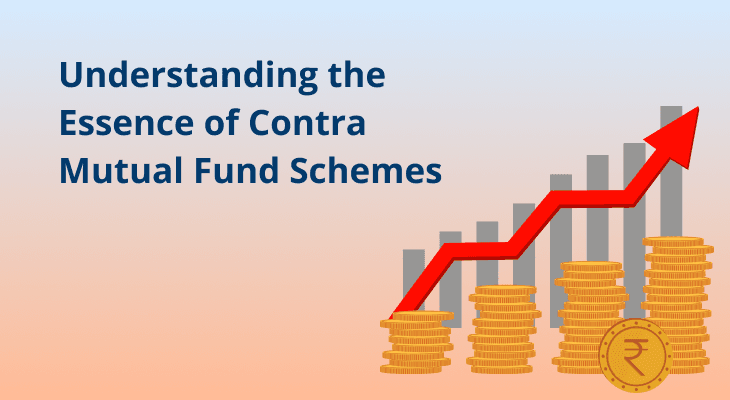
Understanding the Essence of Contra Mutual Fund Schemes
The digital age has made accessible a wide variety of investment avenues, making the choice for investors overwhelming at times. In the diverse financial landscape, Multi-Asset Allocation Funds are another investment option that can be quite suitable for you if you’re seeking a diversified and well-balanced portfolio. However, like any financial instrument, understanding their nuances is crucial before investing in them. In this insightful article, we delve into the depths of what multi-asset allocation funds are and unravel essential aspects that every investor should consider.
What are Contra Mutual Funds?
Contra Mutual Funds stand out in the mutual fund landscape with their ‘contrarian’ investment strategy. Unlike traditional funds, they deliberately go against prevailing market trends, investing in stocks or sectors that are currently out of favour. The objective is to identify opportunities where the market may be undervaluing potential growth and assets that may experience a reversal in fortune in the future leading to gains for the investor.
Are Contra Mutual Funds Right For You?
Contra Mutual Funds cater to investors seeking a distinctive approach to wealth creation. While not suitable for everyone, they offer a counterbalance to conventional investment options for those willing to embrace a contrarian perspective. You may find these funds appealing if you have:
a higher risk tolerance,
an understanding of contrarian strategies,
a long-term investment horizon,
a to diversify your portfolio with an unconventional strategy,
the patience to investment in funds that may contradict popular market trends,
and, the ability to navigate and endure market fluctuations without panicking.
Critical Factors to Consider Before Investing
Before investing in Contra Mutual Funds, there are several crucial factors that should be considered.
Risk Tolerance
First and foremost, you should assess your risk tolerance, as Contra Mutual Funds may exhibit higher volatility due to their contrarian approach. Ensure your risk appetite aligns with the potential fluctuations in the fund's performance.
Investment Horizon
Then, define your investment horizon. Contra strategies may take time to deliver their desired results. This makes these funds more suitable for those with a longer-term perspective.
Understanding Contrarian Approach
Since it is an off-beat strategy, it is important to familiarise yourself with the contrarian investment philosophy. Understand that Contra Mutual Funds deliberately go against market trends, aiming to identify undervalued opportunities that may be overlooked by mainstream investors. Moreover, evaluate how the contrarian strategy aligns with your overall investment goals. Ensure it complements your existing portfolio and adds a layer of diversification rather than introducing unnecessary risk.
Track Record Of Fund Manager
Investigating the track record and expertise of the fund manager is necessary as well. A skilled manager adept at implementing contrarian strategies is crucial for the fund's success.
Market Conditions
Always consider the prevailing market conditions. Contrarian strategies may be more effective during certain market phases, and understanding these conditions can enhance your expectations and decision-making.
Historical Performance
Scrutinise the historical performance of the Contra Mutual Fund. Analyse how it has performed in different market cycles to gauge its resilience and effectiveness in varying economic conditions. But do keep in mind that historical performance is no guarantee for future returns.
Expense Ratios
Compare the expense ratios associated with the various contra funds available in the market. Ensure that the costs are reasonable and justified given the fund's strategy and historical performance.
Liquidity Of The Fund
Assess the liquidity of the Contra Mutual Fund. A liquid fund ensures that you can easily buy or sell units, providing flexibility in managing your investment. Else your investment may get blocked longer than your desired horizon.
Impact Of Market Trends
Understand how the fund's performance is impacted by market trends. Contra Mutual Funds thrive when there is a potential for a market reversal, making them sensitive to shifts in broader market sentiment.
Diversification Benefits
Analyse how the fund contributes to your overall portfolio diversification. Ensure it complements your existing investments and enhances the overall risk-return profile of your portfolio.
Tax Implications
Consider the tax implications associated with Contra Mutual Funds. Understand how gains are taxed and whether the fund's strategy aligns with your tax planning objectives.
Exit Load And Redemption Policies
Review exit loads and redemption policies. Understanding any associated costs and restrictions on redeeming units can help you make informed decisions regarding the timing of exits.
In conclusion, contra mutual funds offer a distinctive investment strategy by going against the market grain. The contrarian approach aims to capitalise on opportunities that may be overlooked by mainstream investors, providing a counterbalance to conventional investment strategies. While not a magic potion for all portfolios, incorporating a contra fund can add a layer of diversification for investors seeking to embrace a contrarian perspective in their wealth-building journey.
SIPs let you invest small amounts regularly, making it easier to stay consistent with your goals. With time, your money grows faster through compounding, helping you get the most out of your investments. Try our SIP Calculator to see how your money can grow and make smarter plans for your future.
FAQ
What are Contra Mutual Funds?
Contra Mutual Funds, categorised as contrarian funds, are different from traditional mutual funds since they intentionally deviate from prevailing market trends. These funds strategically invest in stocks or sectors that are currently out of favour, aiming for potential future reversals in market sentiment.
Why should I choose a Contra Mutual Fund?
Investors opt for Contra Mutual Funds to introduce a unique layer of diversification to their portfolio. These funds offer a strategic approach, capitalising on potential market reversals and identifying opportunities that may be disregarded by conventional investment strategies.
What risks are associated with Contra Fund Schemes?
The primary risk with Contra Fund Schemes lies in the higher volatility resulting from their contrarian approach. As these funds intentionally go against prevailing trends, there may be periods of short-term underperformance before the contrarian strategies manifest positively.
Is a high-risk tolerance necessary for investing in Contra Funds?
Yes, a higher risk tolerance is advisable for investors considering Contra Funds. Given the potential for short-term volatility and underperformance, individuals with a greater appetite for risk are better suited to weather the inherent fluctuations.
How does the fund manager impact Contra Fund performance?
The performance of Contra Funds is intricately tied to the expertise and strategic decisions of the fund manager. A skilled manager proficient in identifying undervalued opportunities and successfully implementing contrarian strategies plays a pivotal role in the fund's success.
Can Contra Mutual Funds provide long-term benefits?
Indeed, Contra Funds are tailored for investors with a long-term perspective. Patient investors willing to endure short-term market fluctuations and wait for contrarian strategies to materialise may experience substantial benefits over the extended investment horizon.
Are Contra Funds tax-efficient investment options?
The tax efficiency of Contra Funds is contingent on factors such as the holding period and gains. Investors should thoroughly understand the tax implications specific to Contra Funds, considering the potential benefits and drawbacks, to make informed investment decisions aligned with their financial objectives.


